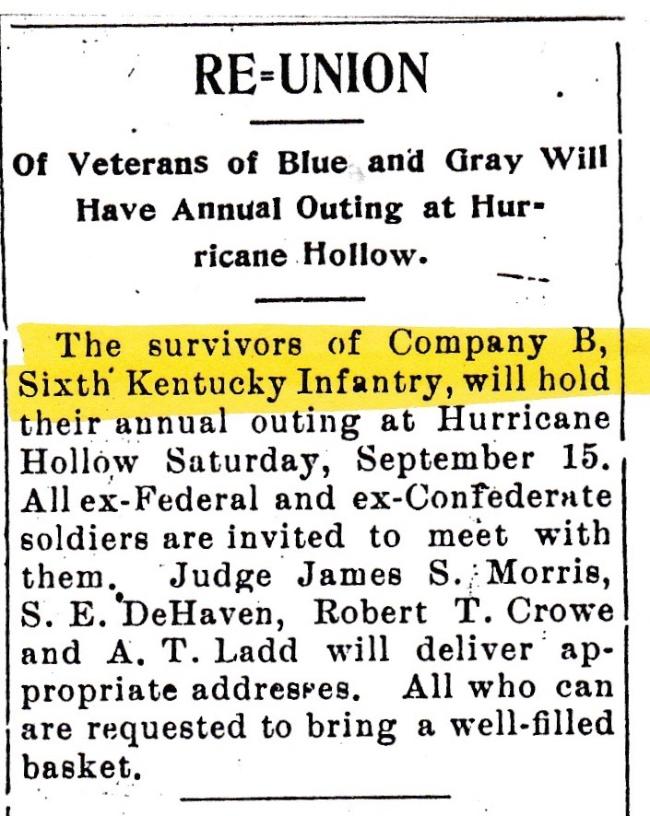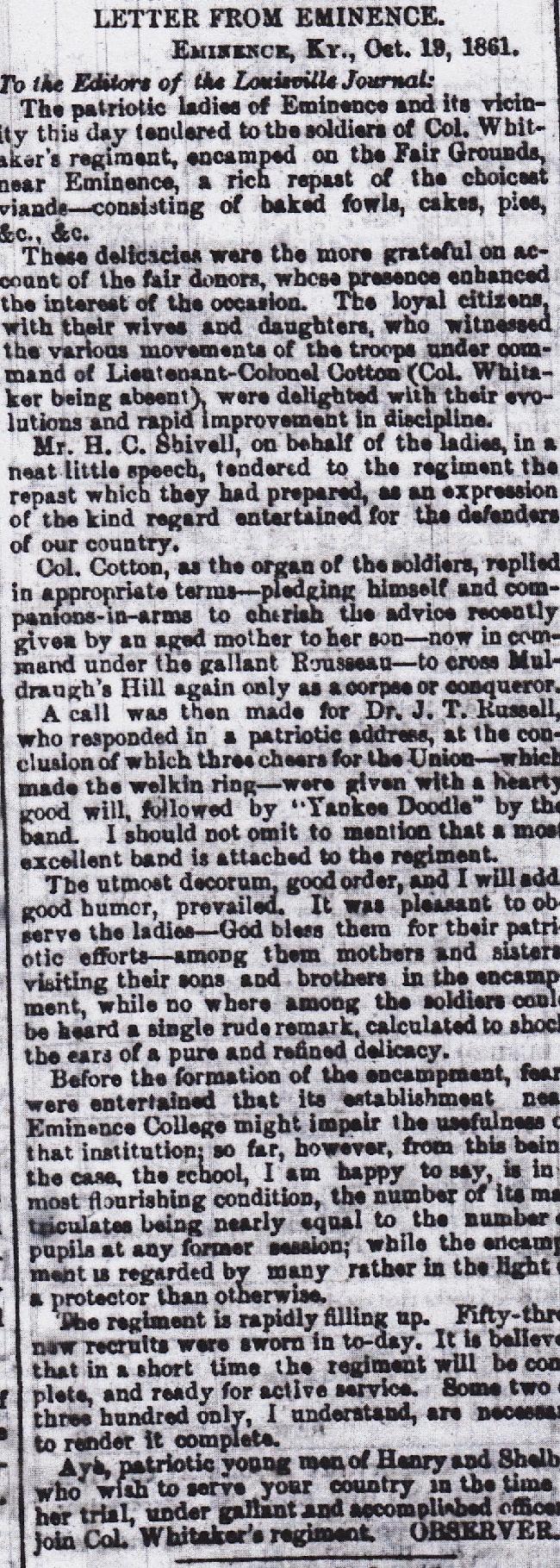From Dyer's Compendium of Union Regiments:
6th Regiment Infantry
Organized at Sigel, Muldraugh's Hill and Shepherdsville, Ky., September 9 to December 24, 1861. Attached to Rousseau's 1st Brigade, McCook's Command, at Nolin, Ky., to November, 1861. 12th Brigade, Army of Ohio, to December, 1861. 12th Brigade, 1st Division, Army of Ohio, to January, 1862. 19th Brigade, 4th Division, Army of Ohio, to September, 1862. 19th Brigade, 4th Division, 2nd Corps, Army of Ohio, to November, 1862. 2nd Brigade, 2nd Division, Left Wing 14th Army Corps, Army of the Cumberland, to January, 1863. 2nd Brigade, 2nd Division, 21st Army Corps, to October, 1863. 2nd Brigade, 3rd Division, 4th Army Corps, to August, 1864. 1st Brigade, Defenses of Nashville & Chattanooga Railroad, to September, 1864. Unattached, 4th Division, 20th Army Corps, to November, 1864. District of Kentucky to January, 1865.
SERVICE.--Engaged in the Defense of Eastern Kentucky before muster. Moved to Lebanon, Ky., November 28, 1861. Skirmish at Bagdad, Selby County, Ky., December 12, 1861. At Camp Wyckliffe, Ky., until February, 1862. Advance on Nashville, Tenn., February 14-25. Occupation of Nashville February 25-March 18. March to Savannah, Tenn., March 18-April 6. Battle of Shiloh, Tenn., April 7. Advance on and siege of Corinth, Miss., April 29-May 30. Occupation of Corinth May 30, and pursuit to Booneville May 31-June 12. Buell's Campaign in Northern Alabama and Middle Tennessee June to August. Flat Lick, Tenn., August 17 (Detachment). March to Louisville, Ky., in pursuit of Bragg August 17-September 26. Pursuit of Bragg to Loudon, Ky., October 1-22. Battle of Perryville, Ky., October 8. Danville October 11. Near Crab Orchard October 15. Wild Cat Mountain, near Crab Orchard, and Big Rockcastle River, near Mt. Vernon, October 18. Pittman's Cross Roads October 19. March to Nashville, Tenn., October 23-November 6, and duty there until December 26. Advance on Murfreesboro, Tenn., December 26-30. Springfield, Ky., December 30 (Detachment). Battle of Stone's River December 30-31, 1862, and January 1-3, 1863. At Murfreesboro until June. Woodbury January 24. Expedition to Woodbury April 2. Snow Hill, Woodbury, April 3. Middle Tennessee (or Tullahoma) Campaign June 24-July 7. Liberty Gap June 24-27. Occupation of Middle Tennessee until August 16. Passage of Cumberland Mountains and Tennessee River and Chickamauga (Ga.) Campaign August 16-September 22. Lee and Gordon's Mills, Ga., September 11-13. Battle of Chickamauga, Ga., September 19-20, Siege of Chattanooga, Tenn., September 24-November 23. Reopening Tennessee River October 26-29. Brown's Ferry October 27. Chattanooga-Ringgold Campaign November 23-27. Orchard Knob November 23-24. Mission Ridge November 25. March to relief of Knoxville November 28-December 8. Operations in East Tennessee December, 1863, to April, 1864. Atlanta Campaign May 1 to August 19, 1864. Demonstrations on Rocky Faced Ridge and Dalton May 8-13. Battle of Resaca May 14-15. Adairsville May 17. Near Kingston May 18-19. Near Cassville May 19. Advance on Dallas May 22-25. Operations on line of Pumpkin Vine Creek and battles about Dallas, New Hope Church and Allatoona Hills May 25-June 5. Pickett's Mills May 27. Operations about Marietta and against Kenesaw Mountain June 10-July 2. Pine Hill June 11-14. Lost Mountain June 15-17. Assault on Kenesaw June 27. Ruff's Station, Smyrna Camp Ground, July 4. Pace's Ferry July 5. Chattahoochie River July 6-17. Peach Tree Creek July 19-20. Siege of Atlanta July 22-August 19. Ordered to Chattanooga, Tenn., August 19. Garrison duty there and at Bridgeport, Ala., until November 2. Moved to Nashville, Tenn.; thence ordered to Louisville, Ky. Mustered out September 23, 1864, to January 2, 1865.
Regiment lost during service 10 Officers and 105 Enlisted men killed and mortally wounded and 5 Officers and 96 Enlisted men by disease. Total 216.
From Thomas Speed's The Union Regiments of Kentucky:
Sixth Kentucky Infantry
The 6th Ky. Infantry was composed of three different organizations, each of which had originally been intended to be a regiment. Two companies - Capts. Martin and Haupstoff - had organized at Camp Holt, under Maj. John R. Pirtle, in July, 1861. They accompanied the troops, which went from that camp to Muldraugh’s Hill in September. They did not join either the Louisville Legion or the 2d Cavalry, but subsequently became a portion of the 6th Infantry.
In September, Col. Walter C. Whitaker was commissioned to raise a regiment at Eminence, Ky. About the same time William Elwang was authorized to raise a regiment at Louisville. The men recruited by Whitaker were brought by him to Louisville, and uniting with those recruited by Elwang went into Camp Sigel, near Louisville, on the Preston street road. The two companies above mentioned were ordered to this camp from Muldraugh’s Hill, and the three contingents thus provided united in forming the 6th Ky. Infantry. Up to this time the Camp Holt companies had been under command of Maj. John R. Pirtle. Walter C. Whitaker became the colonel; George T. Cotton, lieutenant-colonel; William N. Hailman, Major; George T Shackelford, adjutant; Michael Billing, quartermaster. Maj. Pirtle afterward became surgeon in another regiment.
In December, 1861, the regiment marched to Bardstown, and from thence to Camp Wickliffe, in Larue county, where other troops were assembling. It was brigaded there with the 41st Ohio, 9th Ind. and 1st Ohio Battery, under Col. William B. Hazen, of the 41st Ohio.
In February the division to which the 6th belonged was ordered to the mouth of Salt river, from whence it proceeded by transport to Paducah, and up the Cumberland to Nashville. From Nashville, it accompanied Buell’s army to Pittsburg Landing, and was heavily engaged in the second day’s battle of Shiloh, being engaged during the whole day, skirmishing, resisting and making charges, supporting batteries and making reconnoissances. The regiment is mentioned in the most complimentary manner in the official reports. The service it performed is shown by its losses, twenty-six killed on the field, and ninety-one wounded, nineteen of the latter dying, making a loss of forty-five killed. Among the wounded were Capts. Hedden, Johnston, Stein, McLeod. The color-bearer, Richard T. Thornton, was killed. Lieut. John L. Chilton was taken prisoner, but his men rushed upon his captors and rescued him, killing six of the enemy in doing so. The experience of this regiment at Shiloh, severe as it was, was not more so, as will be seen, than that at Murfreesboro.
From Shiloh, the regiment proceeded to Corinth, thence to Athens, Ala., and in the summer and fall of 1862 accompanied Buell in the march to Louisville. After the battle of Perryville, it marched as far as Columbia, Ky., then to Nashville and Murfreesboro. The battle of Murfreesboro, or Stone’s River, occurred December 31, 1862.
The position of the 6th was near the burnt brick dwelling of McGowan. Shortly after sunrise, the 31st, its pickets were attacked. Heavy fire was heard on the right, and directly a furious attack occurred on the left. The pickets of the 6th were driven in, and the enemy charged in force. Three assaults were made on the position held by the 6th, and all were repulsed. The 6th was then advanced to drive the enemy from the cover of the wood. In this movement, which was successful, Lieut. Col. Cotton was killed. The 6th was then attacked and held its position until its ammunition was exhausted. Falling back a short distance, and replenishing ammunition, it held the position taken, on the north side of the railroad embankment. Beginning about 2 p.m., this position was furiously assailed three different times, but it was held. The losses were Lieut. Col. Cotton and Capt. Charles S. Todd, killed; Lieuts. Bates, Dawkins, Armstrong and Frank, wounded; total killed and wounded, one hundred and seven. Among those mentioned for gallantry were Sergt. William Jones, Capts. Dawkins, Marker and Stein: Lieuts. McCampbell, Johnston, Whitaker, Frank, Campbell and Melcher.
On January 2d, the 6th was again engaged, resisting an attack successfully, losing several killed and wounded. A monument is erected to the 19th Brigade - Hazen’s - at Stone’s River, where the 6th Infantry lost over 30 per cent of its men engaged.
During the spring of 1863, the 6th Infantry was with the extreme left of Rosecrans’ army in its organization, and was twice engaged with the enemy, at Readyville and Woodbury, Tenn.
On the 28th of June, the movement on Chattanooga began. The 6th was still in Hazen’s brigade, Palmer’s division, Crittenden’s corps. The movement of this body of troops was across the mountains, through Sequatchie Valley and across Walden’s ridge to Poe’s Station. Col. Whitaker had been made a brigadier-general, and the regiment was led by Col. Shackelford.
Preceding the battle of Chickamauga, the only engagement the 6th had was the result of a reconnoissance to Eigho Ferry.
The part the 6th bore in the battle of Chickamauga was first as reserve, but soon was taken into the heaviest fighting. Col. Shackelford was wounded, and Lieut. Col. Rockingham was killed. Capts. McGraw, Johnston and Marker, and Lieuts. Lockman and Eubanks, were also killed. The loss of men in the regiment was very heavy. Gen. Hazen, in his report, says: "The 6th Ky., from the great mortality among its officers, was much broken."
The 6th Ky., being still in Hazen’s brigade, took part in the work of opening communications to Chattanooga. Its volunteers manned a fleet, which made the surprise at Brown’s Ferry, and captured the picket force there. It was in the charge at Orchard Knob, in the great battle of Mission Ridge, and participated in the capture of the two oft-mentioned guns, "Lady Buckner" and "Lady Breckinridge."
After the battle of Mission Ridge, the 6th was with the troops sent by Gen. Grant, under Gen. Sherman, to the relief of Burnside, at Knoxville, in November, 1863. In December, it was at Blaine’s Crossroads, above Knoxville. In January, 1864, it was at New Market; in February, at Morristown; in March, at Powder Spring Gap; in April at McDonald Station.
In the spring of 1864, the 6th was still with Hazen’s brigade, in Wood’s division of the 4th Corps, and entered upon the Atlanta campaign. With its accustomed gallantry and devotion to duty, it participated in various battles of this campaign, including Dalton, Buzzard Roost, Resaca, Rocky Face, Dallas, Kennesaw, Peach Tree Creek, and other battles around Atlanta.
The severe service of the 6th had reduced its strength and the remaining members returned to Tennessee and garrisoned the railroad, near Cowan’s Station, until November 2d, when it was taken to Nashville, where it was mustered out.
A small number of the regiment re-enlisted in the veteran organization, and were transferred to the 4th Ky. Mounted Infantry. None of the Kentucky regiments had a better record than the 6th. Of nearly one thousand men who left Louisville in December, 1861, only one hundred and thirty returned. Of the thirty-eight officers commissioned, only ten returned, and of these only six escaped wounds.
Oldham County Era September 6, 1906

Louisville Daily Journal October 22, 1861
